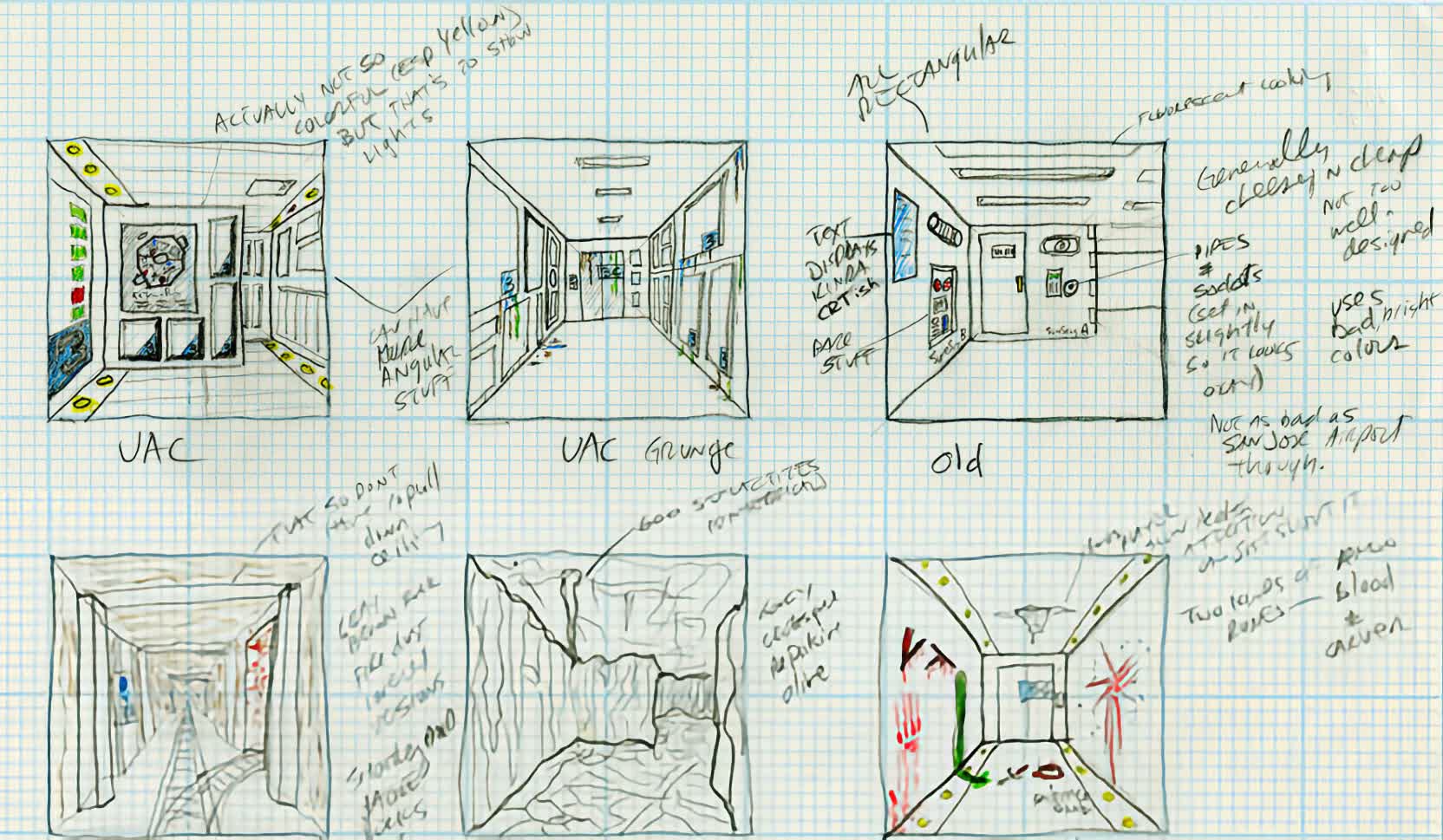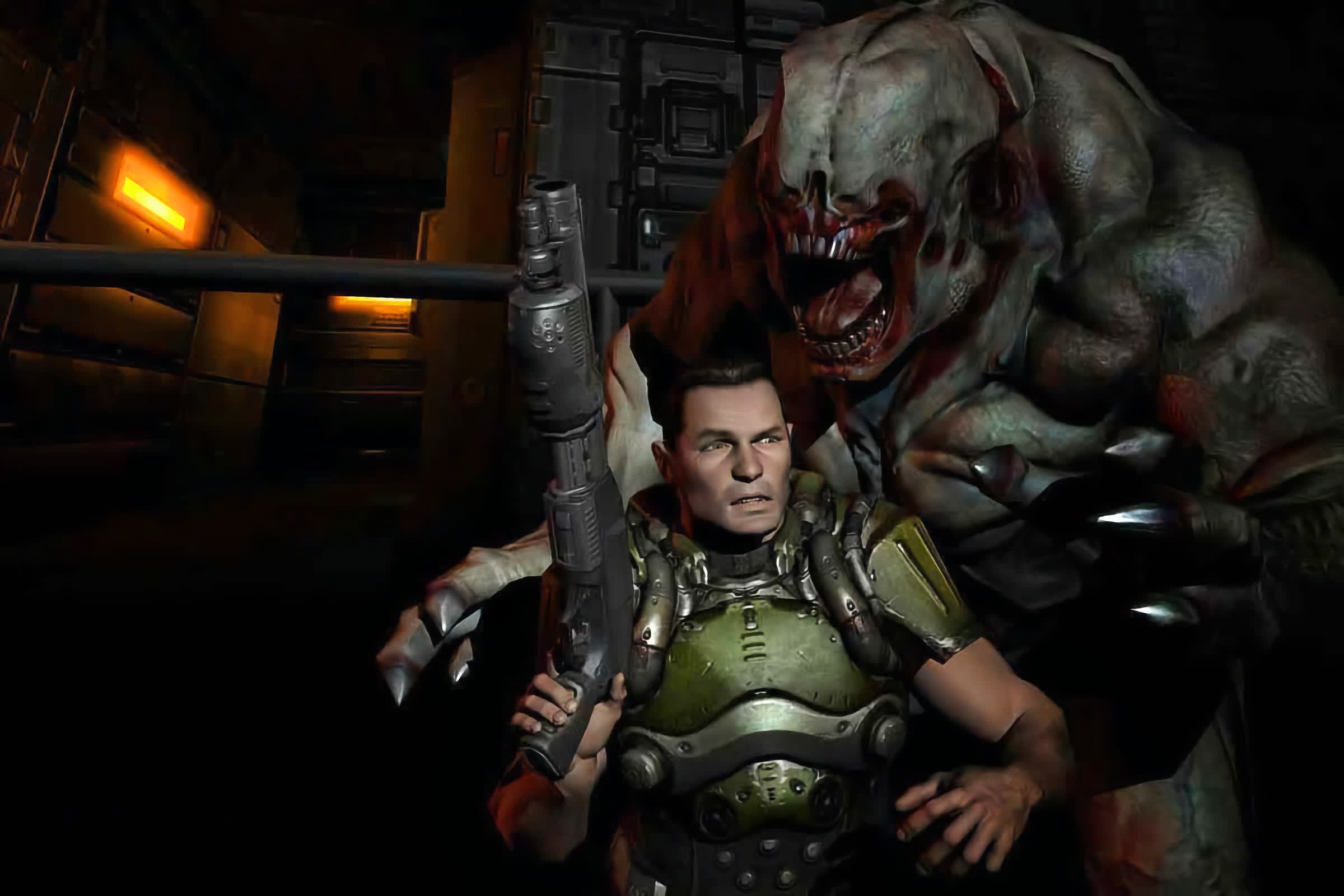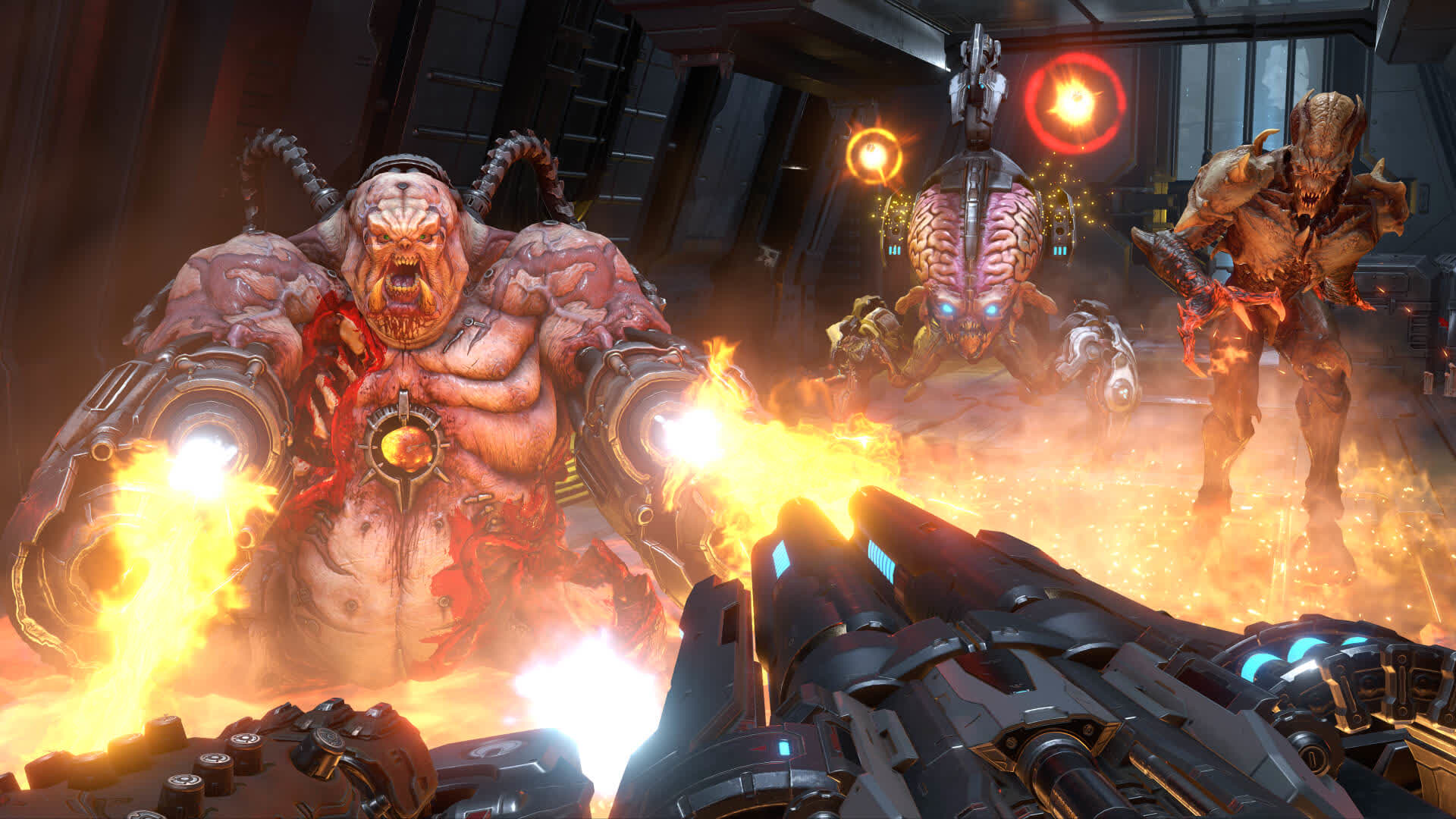Much like Super Mario Bros. and Sonic the Hedgehog, Doom is a name that people who “know nothing about video games” recognize. It’s one of the industry’s most influential and longest-running franchises – 30 years and counting –spawning several games, novels, a comic book, and two movies of questionable quality.
While it’s true that Doom was not the first FPS, it is rightly considered the granddaddy of the genre; a claim few games can make. In this feature, we look at each entry in the series from development to reception, starting with the seminal original and ending with Doom Eternal’s expansions.
“They are rage, brutal, without mercy. But you. You will be worse. Rip and tear, until it is done.”
DOOM (1993)
Doom was not id Software’s first FPS; that honor goes to 1992’s Wolfenstein 3D, whose popularity led to a similar game, one that swapped Nazis for demons and boasted a more complex engine: Doom.
After considering making another entry in the Command Keen platformer series, id Software co-founder John Carmack came up with the concept of fighting demons using technology, taking inspiration from the team’s in-progress Dungeons and Dragons campaign and combining the styles of Evil Dead II and Aliens.
Originally the game had been named “Green and Pissed,” but Carmack renamed it Doom. If you’ve ever wondered where the iconic name came from, it’s a line from the 1980s Tom Cruise/Paul Newman classic The Color of Money…
Tom Hall came up with the Doom Bible design document that described an extensive plot and lore. Carmack, more interested in the technical side of design, famously said, “Story in a game is like story in a porn movie; it’s expected to be there, but it’s not that important.”
Doom was revolutionary, introducing features far beyond what we’d seen before: verticality, full texture mapping, non-orthogonal levels, dynamic lighting, and more. It was also genuinely scary at the time—this writer remembers letting out a yell when a Pinky appeared unexpectedly—partly due to the creatures that were created as physical models before being scanned and placed into the game.

Carmack’s quote about the plot not being important proved right. Doom’s fast-paced action, graphics, and simple addictiveness made it a smash hit. Many remember the complex levels mixed with visceral gameplay and meaty weapons such as the legendary BFG 9000 and chainsaw, but it was the multiplayer mode that helped seal its place as arguably the most influential shooter of all time. And it didn’t even have the ability to free look with the mouse, not that we cared back then.
Doom was one of the first multiplayer FPS titles—The Guinness Book of Records lists Midi Maze for the Atari ST as the first—introducing PvP deathmatches and co-op campaigns for wired networks. The mode was so popular that universities were forced to ban the game hours after its release due to the strain placed on their networks.
Doom user-generated content has helped keep it alive nearly three decades after launch. The game’s data, including its levels, graphics, and music, are stored in separate WAD (Where’s All the Data) files, allowing modifications without the need to alter the engine code.
On December 10, 1993, a shareware copy of Doom was uploaded to an FTP server at the University of Wisconsin. Ten thousand people tried to download the game at once, crashing the network. It’s estimated that 15-20 million people played this version, consisting of the nine-level first episode. The full, three-episode game was sold via mail order.
It might seem tame by today’s standards, but the gore and satanic imagery in Doom brought it plenty of controversy at the time. It was one of the games blamed for the Columbine shooting. Wolfenstein 3D may have set the groundwork, but every FPS that followed Doom owes it a debt of gratitude.
You can download and play the original Doom and Wolf3D free of charge these days.
Doom II: Hell on Earth (1994)

With the incredible success of Doom, it didn’t take long for a sequel to arrive—just ten months after its predecessor’s release. Doom II was a case of “if it ain’t broke, don’t fix it,” but do make it bigger, better, and introduce one of the best weapons ever to grace a computer screen.
Sandy Peterson, who worked on the first game and created the Call of Cthulhu tabletop RPG, was joined by a young American McGee and Shawn Green to create new levels.
Players once again take control of Doom Guy in a game with the thinnest of plots, which likely gained Romero’s blessing. As the title suggests, the forces of Hell have left Mars for Earth. A few memorable beasts make their first appearance in Doom II, including the Hell Knight (goat’s legs, horny), Arachnotron (robospider), Revenant (skeleton with rocket launcher-sporting shoulder pads), Pain Elemental (a D&D Beholder’s cousin), and Mancubus (heavy-set cyborg demon with six toes, stumpy elephant legs, and arms that can shoot fireballs).

Ask people what they remember about Doom II, and most will say the same thing: the Super Shotgun. While it’s true that you could brew a pot of coffee in the time this double-barrel sawn-off takes to reload, it still appears on many “greatest video game weapons of all time” lists. The sheer power and satisfaction that comes from blowing several demons to pieces with its wide spread still resonate today.
Doom II also had a better multiplayer element, with more support and features when playing co-op and in deathmatches.
Interestingly, unlike the first Doom, Doom II was never released on a large number of platforms such as the Sega 32X, 3DO, SNES, etc., but was limited to the MS-DOS and Mac OS in the 1990s, though there was a Game Boy Advance version in 2002.
While the Doom II experience didn’t differ that much from its predecessor, it still became the best-selling video game of 1994. It was also the highest-selling id Software game (2 million units) for many years.
Doom 64 (1997)

With Romero gone and id Software having moved beyond Doom with another genre-defining FPS called Quake, the team behind the PlayStation port of Doom, Midway Studios San Diego, took the helm for Doom 64, with the original developer supervising.
Following directly on from Doom II, Doom 64 took full advantage of the Nintendo 64’s power. While the gameplay was the same, the pixelated graphics were replaced by smoother and larger sprites. There are darker environments, intensifying the foreboding vibe, along with new textures, more scripted events, and a couple of new monsters.
Another interesting change in Doom 64 is the weapons. The chainsaw now has two blades, and there’s a new firearm called the Unmaker that’s upgradable to become faster and shoot extra beams. Sadly, Doom 64 lacked the much-loved Deathmatch mode.
Despite being the best-looking Doom to date and featuring more puzzle-like, complex levels, not all critics and players loved Doom 64 upon release, though it’s gained more fans over the years. You can decide for yourself by checking out the dirt-cheap PC port on Steam, where it has a Very Positive rating.
Doom 3 (2004)

Yes, it really has been fifteen years since Doom 3 launched. The plan to remake Doom using modern technology began in 2000, but a few id Software employees were worried the franchise had run its course and that another entry wasn’t the right way to go. Thankfully, the success of the excellent Return to Castle Wolfenstein ensured we’d see the return of the demon-killing marine.
Surprisingly, the first person to publicly unveil Doom 3 (via John Carmack) was none other than Apple’s CEO Steve Jobs at the Macworld Conference & Expo 2001 in Tokyo, when he was also introducing the GeForce 3.
The id Tech 4 engine showed how far technology had come in the years since Doom. Advanced lighting and shadows, more complex animations, and interactive surfaces helped make Doom 3 as much a full-blown horror as a shooter—as those who soiled their pants when looking in the bathroom mirror will attest. It’s almost half an hour into the game before you actually shoot anything, and some dark areas force you to use a flashlight instead of a weapon; it’s one or the other, a quirk of the game that divided opinion.
Doom 3’s narrative was fleshed out and interesting for a change. id Software even hired a professional science-fiction writer named Matthew J. Costello to create the script and assist in storyboarding. Doom 3 is set on a Mars base—and partly in Hell—with a plot involving the Union Aerospace opening a gateway that allows demons to saunter through, but now we get a lot more than just screens of text explaining what’s going on, with actual cutscenes and lengthy dialogue. There’s also the RPG trope of emails, logs, and video messages that fill in more of the backstory, as well as containing access codes
Another significant change in Doom 3 is that reloading is necessary, with each weapon requiring specific ammo types. There are new enemies to deal with, and many of the traditional demons have been given a modern makeover.
Most critics and gamers loved Doom 3, praising the looks, presentation, and atmosphere, though there were a few players who believe it moved a bit too far from the frantic pace of its predecessors, and many found the “torch or weapon” option a pain in the ass. By 2007, over 3.5 million units had been sold, making it id Software’s most successful game up to that point.
Doom 3: Resurrection of Evil (2004)

While Resurrection of Evil (ReO) is an expansion to Doom 3 that requires the base game (except on Xbox), it’s worth a mention for some of its additions. Developed by Nerve Software, which had previously worked on the multiplayer mode and Xbox port of Return to Castle Wolfenstein, Doom RoE is set two years after the events of Doom 3. It features a 12-level campaign, six new enemies, four multiplayer maps, and some new weapons, including the much-missed super shotgun.
Some memorable elements of RoE are the Ionized Plasma Levitator, aka the Grabber, which is Half-Life 2’s Gravity gun in everything but name, and The Artifact, aka the Heart of Hell, which can slow down time, give players and their weapons berserk strength, and make them temporarily invulnerable.
Doom 3: Resurrection of Evil received mostly positive ratings, though some complained that it was retreading old ground.
Doom (2016)

Twelve years after Doom 3 and three years after co-founder John Carmack left the company to become CEO of Oculus VR, a rebooted Doom was set upon the world.
The game had a colorful development: initially announced as Doom 4 at QuakeCon 2007, it fell into the category of “development hell” a few years later. According to reports, Doom 4’s heavily scripted events and cinematics made it more akin to a Call of Duty game, but, thankfully, most of this ended up discarded. The parts left over evolved into one of the best games of the decade.
The new Doom went back to basics, abandoning the slow-paced, survival horror-like elements of Doom 3 for fast and frantic gunplay—reloading weapons is once again a thing of the past—and the Tech 6 engine looks fantastic even today.
While the plot is once again more coherent than the originals, Doom’s gameplay remains its most memorable element. The experience is a furious pulse racer, the physical incarnation of a thrashing heavy metal track, testosterone in video game form, liquid death.
Despite the frantic action, there’s plenty of exploring to be done in Doom, from hunting down the keycards and skullkeys to uncovering secrets. It also adds depth to the weapons, with alternate fire modes and upgradeable mods, making for some very satisfying demon-killing devices. And then there’s the visceral Glory Kills: melee executions that can be carried out once an enemy’s health is low enough in return for some health. Using the chainsaw, meanwhile, brings ammo.
Despite the “never stand still” mantra, Doom is often a tactical game that requires plenty of thought, especially in big fights when deciding which monster to take down first and with what weapon. Players must also consider the most opportune moments for dishing out glory/chainsaw kills.
Combine all this with the time trials, Mick Gordon’s pounding soundtrack, and the SnapMap level editor, and you’ve got a game worthy of carrying the Doom name, even with the pretty weak multiplayer segment. Doom was praised by critics and players alike, receiving multiple nominations and awards at gaming events. For many fans, it remains their favorite entry in the series.
Doom VFR (2017)
Another entry away from the main series, Doom VFR answers that question, “Can you imagine how awesome Doom would be in virtual reality?” Not particularly, it seems.
Being VR, you have to rely on a combination of “teleport” and “dash” buttons to move around. A lot of the Doom 2016 elements are here, from Glory Kills to virtually every enemy from the main game, but it is very cut down—expect to complete the campaign in around three hours.
Doom VFR has a Mixed rating on Steam, with most of the complaints aimed at the awkward controls, bugs, and lack of polish. Doom in virtual reality could be amazing, but not like this.
Doom Eternal (2020)

Given the positive reception Doom 2016 received, the announcement of Doom Eternal at E3 2018 generated plenty of excitement. Like 1994’s Doom 2, most of the action takes place on earth, and there are plenty of similarities to Doom 2016, but it’s a very different game in many ways.
Doom Eternal is intense. Very intense. Some people complain that it goes a bit too far in this respect, becoming stressful rather than fun. The same heat-of-battle decisions you needed to make in the previous game are still here, along with a bucketload of extra elements to consider: in addition to Glory Killing for health and chainsawing demons for ammo, you can now set enemies ablaze to receive armor; there’s the monstrously powerful Blood Punch; and ice bombs/frag grenades to utilize. All these factors must be considered while continuously avoiding attacks, making it one of the most adrenaline-pumping games ever made.
Upgrading and modding weapons with alternate fire modes return from the last game, and we now get a grappling hook for the Super shotgun. Movement is enhanced with the ability to swing from monkey bars, and there are new enemies and weapons.
Additionally, there are several asymmetric multiplayer modes, a Fortress of Doom hub, Slayer Gates, weekly challenges—loads to keep you occupied long after finishing the tough campaign.

Doom Eternal arrived to a mostly positive reception, especially from reviewers, though it wasn’t without its detractors. As previously mentioned, the intense, unrelenting pace may be a bit too much for some people. The number of options available can feel overwhelming, and not everyone likes platforming in a Doom game. Still, it sold nearly three times the number of units in its launch month than its predecessor and won Best PC Game and Best Action Game at the Game Critics Awards 2019.
Doom Eternal: The Ancient Gods Part One (2020)
What’s unusual about Doom Eternal’s two expansion episodes is that they don’t require ownership of the base game, though it would be unwise to dive in without honing your skills in the original campaign first. As hard as Eternal is, this is even more difficult.
All your bonuses carry over from the main game, which is good as you’ll need them. You get what you would expect from an expansion: more missions, locations, and enemies. One new bad guy is the Spirit, a ghost-like version of Doom 2016’s Summoner, whose ability to possess and supercharge another demon can be teeth-gnashingly annoying.
In a similar way to Doom Eternal, most reviewers and players like the Ancient Gods, but some find its difficulty, especially the sheer number of enemies thrown at the player at once, frustrating.
Doom Eternal: The Ancient Gods Part Two (2021)
Drawing a close to the modern version of Doom is this final expansion for Doom Eternal. There are six extra enemies this time, including a cybernetic armour-clad Baron of Hell, adding to the roster of demons from the base game and the previous expansion.
A major new weapon makes an appearance: the Sentinel Hammer. This area-of-effect monster sends out a shockwave that stuns or kills outright, and is one of the best parts of the TAGPT. Elsewhere, the expansion adds Escalation Encounters for the sadistic completionists out there. Strangely, while critics seem to like Ancient Gods Part 2 more than Part 1, it’s the other way around for gamers; it currently has a Mixed rating on Steam. However, it’s worth noting that a lot of the hate stems from that final boss fight.
Sigil (2009) and Sigil 2 (2023)

In 2009, co-creator of Doom, John Romero, released the “unofficial” spiritual successor to the fourth episode of Doom, Sigil, for free to owners of the original game, though there were also paid-for physical editions that came with retro-themed goodies like a 16 GB USB designed to look like a 3.5-inch floppy disk. There was even a copy bundled with a soundtrack from one-time Guns N’ Roses guitarist Buckethead. While released independent of Bethesda’s ownership, the game publisher later released Sigil as a patch for the console ports of Doom.
Then, in celebration of Doom’s 30th anniversary, Romero released Sigil 2. The “unofficial sixth episode” of Doom. This installment features nine standard levels and two deathmatch levels, each crafted with the same elements that defined the original game. Accompanied by a new MIDI soundtrack by James Paddock and fresh artwork. If you own Doom or Doom II, you can grab the free megawad from Romero’s website. For collectors and enthusiasts, there’s also a physical “shotgun shell” USB edition that comes in an autographed box with a poster, stickers, and more.
The Big Screen
Doom (film)
Back in 2005, Dwayne “The Rock” Johnson, looking nothing like he does today, had just made the move from wrestler to movie star. Doom sees him joined by Karl Urban, best known for The Lord of the Rings: The Two Towers, Dredd, and the profanity-loving pseudo-cockney Billy Butcher from The Boys. Like 95% of movies based on video games, it’s mostly garbage, with a plot that’s only tenuously related to the source material.
Doom’s definitely isn’t on the same vomit-inducing awfulness level as, say, Alone in the Dark, and there’s that famous 5-minute first-person scene at the end, which goes some way to redeeming the rest of the movie.
Doom Annihilation movie
Following the game’s successful relaunch a few years earlier, someone decided to have another crack at making a Doom movie. While this direct-to-video offering is closer to the games in terms of story, that doesn’t make it good. Again, it’s not the worst video game movie out there, but that isn’t an accolade to be proud of.
 TechSpot’s Outstanding Video Game Series
TechSpot’s Outstanding Video Game Series
Sit back, grab some Doritos and Mountain Dew as we revisit some of the most memorable PC video game franchises, from their inception to becoming game series and ultimately cultural phenomena.

